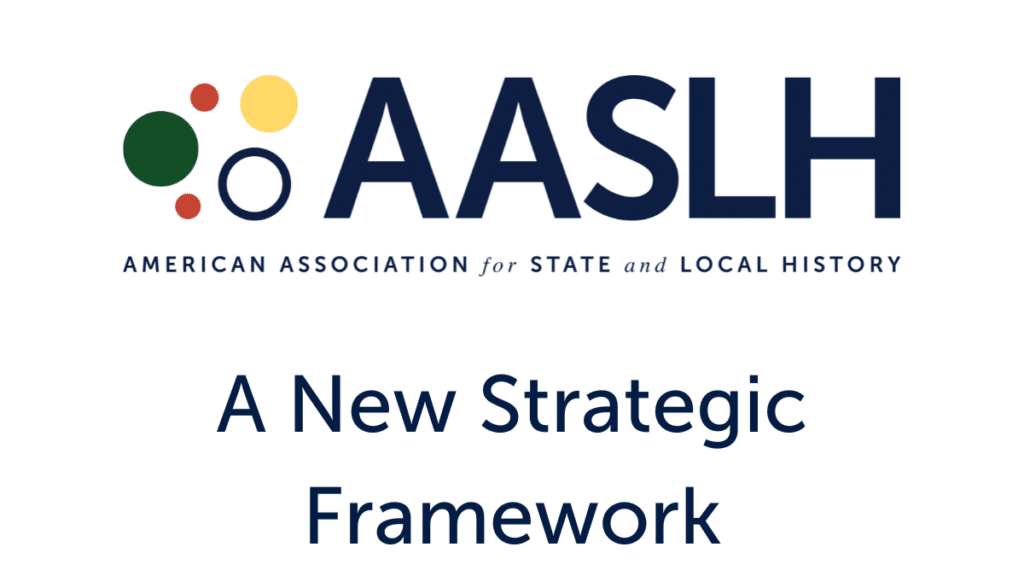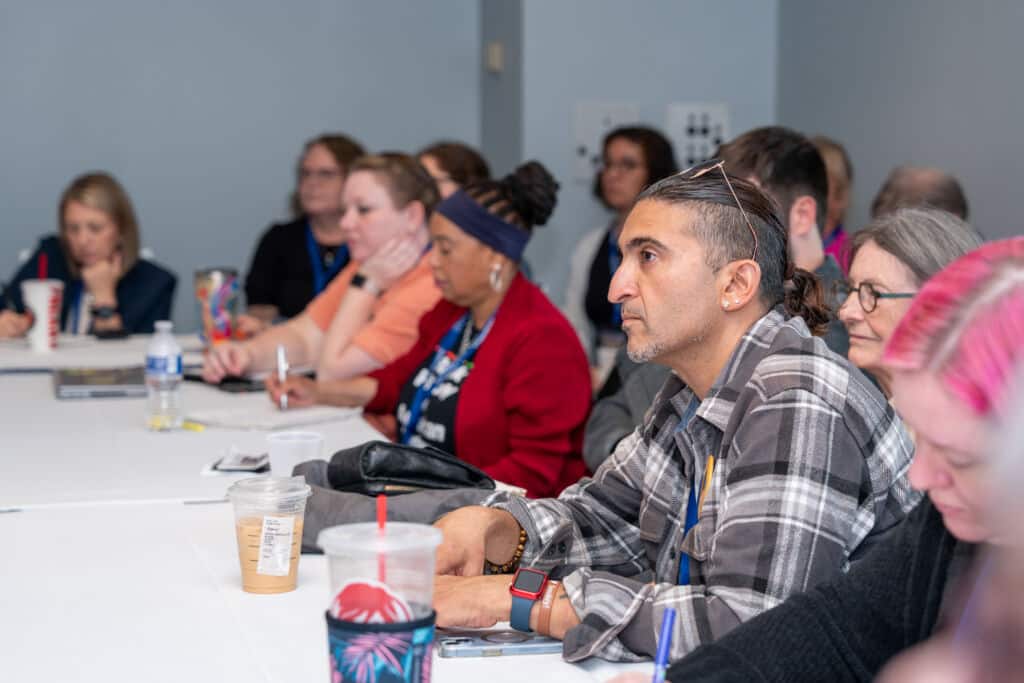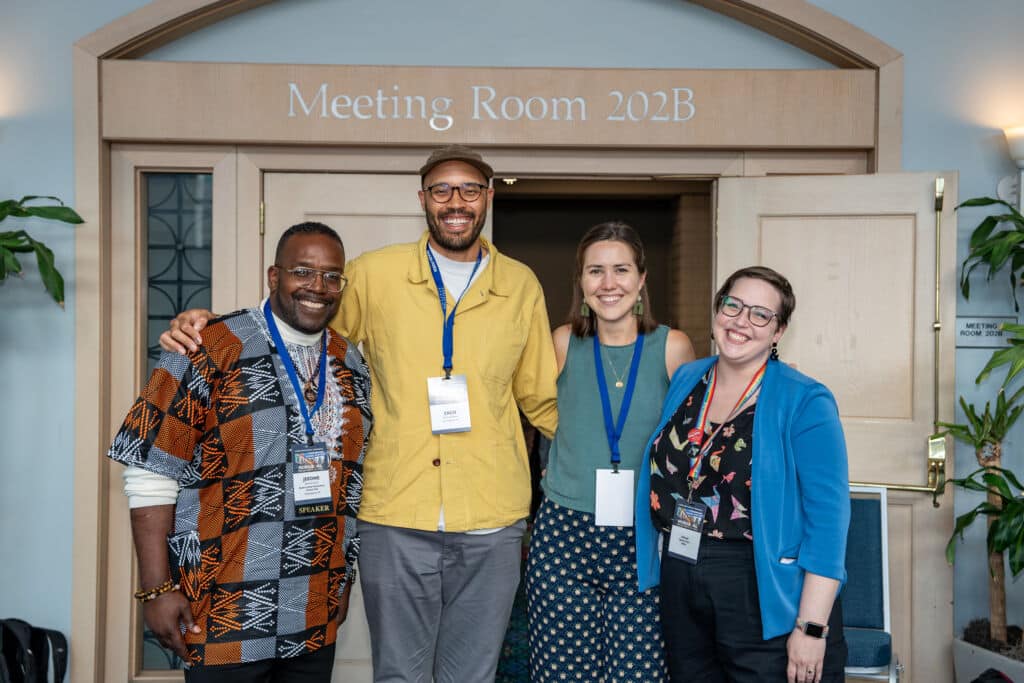
By John Dichtl, AASLH President and CEO
AASLH staff, committees, and Council have been discussing the organization’s strategic direction off and on for the past several months. In this post, I would like to lay out the broad outlines of how we got to where we are today and share the current draft strategic framework for your consideration and comment.
Nearly ten years ago, AASLH’s Council began organizing its strategic thinking around four aspirations. First, that the organization would promote the relevance of history. Second, to build diversity and inclusiveness in the field. Third, to shake up AASLH and perhaps other organizations, by cultivating an experimental and creative spirit. The fourth aspiration, emerging from some difficult transitional years for AASLH, was to rebuild financial stability and trust in the organization.
In 2018-2019 the strategy changed a bit. Council, committees, and staff felt that the organization was making progress on creativity, stability, and trust and could replace those goals with others. There were four goals again, and the first remained to “promote history relevance.” On the second goal of promoting diversity and inclusiveness was added the idea of promoting equity in the field. The third and fourth goals turned the focus more to what AASLH would do as a professional association and less on how it would perform, as in with creativity, financial stability, and trust. As of 2018, the new third goal was to “advance public history practice through continuing education for all levels of the field.” From the annual conference to courses and webinars, a growing percentage of staff and committee time would improve our professional development programs, returning to an arena that AASLH had emphasized earlier in its history.
The revised fourth goal added in 2019 was to “Connect the history community to field-wide questions and each other.” This goal was two-sided. Both parts were fundamental to what a professional association or trade association provides for its members. Most important, AASLH was bringing people together, facilitating the sharing of experiences, ideas, and resources between them. Also, stated first in the rendering above, AASLH was conducting research for the field, helping to identify critical issues that the field might need to address.

Strategic Vision at Small Museums session, 2024 Annual Conference in Mobile, Alabama
Without a doubt, trying to operate during the pandemic in 2020 through 2022 reshaped some of the ways the organization functioned and altered some of our priorities. History seemed broadly, obviously relevant, as much of the world looked to the century-old 1918 flu pandemic for clues to dealing with the Covid pandemic. There was also the fervor with which the American public talked more about questions of systemic racism and its historical origins and challenged the veracity and symbolism of historical monuments, particularly those seen as perpetuating the Lost Cause of the Confederacy. History and discussion of history seemed to be everywhere. Council and staff began to question whether AASLH needed to focus on a strategic goal of promoting the idea that history is relevant to contemporary society.
Meanwhile, in 2022, we added a fifth goal to focus on supporting small history organizations. During different periods in AASLH’s 80-year history, reaching and serving small, local organizations had been a priority for the association. Our 2022 National Census of History Organizations made plain that there were many more small history organizations out there than was generally realized and that their numbers—more than 21,000—surpassed the combined totals of all other types of museums. We also learned that more than thirty percent of all history organizations in the country had been founded during the several years leading up to and the several years following the 1976 Bicentennial. In thinking about the impact of the Bicentennial on state and local communities and what the effect of the 2026 Semiquencenntial might be, it was obvious that our field should do more to reach, interconnect, support, serve, and learn from small history organizations.
Then, in late 2023 and early 2024, AASLH staff and Council began discussing what will be coming next for the public history field, after the Semiquincentennial. In every way we can think of, we have been encouraging our members and others in the history field to use the Semiquincentennial as a renaissance, a time of rededication, expansion, and invigoration. Our Annual Conference in 2026 will be a joint event with the National Council for Public History, for example, and we will be asking members of the two organizations to look back on how the public history field has come to be as it is today, and, most importantly, to consider where we are headed. How can we best prepare for the future, looking at a horizon of 25 years from now, a period when Millennials will be winding down their professional careers? (I urge you think about session proposals for the 2025 Annual Conference in Cincinnati on these questions. Conversations started in 2025 will be the basis of discussions at the 2026 Annual Conference.)
This past summer, the AASLH Council and staff asked AASLH committees to weigh in with comments on the strategic framework with the 250th in mind. We asked if the values, vision, mission, and goals as drafted to that point represented the organization they knew and where it should be heading. During the June 2024 Council meeting, Council and staff examined the responses received from committee members and began outlining adjustments to the framework.

Participants at the 2024 AASLH Annual Conference
Several big-picture points emerged in the Council deliberations. First, the strategic framework should emphasize AASLH’s role as a “hub,” a central connecting point or conduit for information, resources, community, research, and innovation. Second, we agreed to remove the goal of promoting relevance and replaced it with a goal that stresses the importance of advocacy. Because of the 250th, AASLH has built numerous new networks and collaborative relationships throughout the history, museum, and cultural organization communities. It makes sense to retain these structures after 2026 for purposes of speaking up on behalf of history organizations and practitioners in an even more effective manner for years to come after the Semiquincentennial is over. Third, Council also wanted to see a greater emphasis in the framework on how AASLH serves the whole community of history organizations, not just our members. Fourth, Council recognized how much the organization’s professional development programs had expanded in the past decade and could grow further, particularly virtually, to help individuals at various stages of their careers as well as to help many different kinds of history organizations. Fifth, the strategic framework should emphasize the promotion of whole, honest history—shared history that creates a sense of belonging, connection, and understanding. (This last point echoes the Value of History statement from the History Relevance Campaign, which AASLH helped lead several years ago.)

The result of the discussions this past summer and fall is the strategic framework that appears below. On behalf of the AASLH Council and staff, I invite you to read it and let us know your thoughts.
AASLH Strategic Framework
MISSION
As the nation’s premier history organization, AASLH provides leadership, resources, and advocacy to help the history community thrive and tell a shared history in which everyone belongs.
VISION
U.S. history organizations will prosper, tell everyone’s story, and be central to important conversations in their communities. As a result, the public will use critical thinking and emotional intelligence skills to actively engage with and address contemporary issues and to value history for its relevance to modern life.
VALUES
1. We believe a complete, shared history advances progress toward a more just society.
2. We build and maintain networks. AASLH serves as a central hub for the history community connecting organizations and practitioners to one another.
3. We are curious. AASLH creates opportunities for thinking critically about questions and challenges facing the field.
4. We are enthusiastic, supportive collaborators. AASLH welcomes opportunities to work with others.
5. We embrace challenges. AASLH aims to find the best solutions, even if they are unconventional.
GOALS
1. Build and support a more inclusive and equitable history community that represents and serves all people.
2. Advocate for the field and help practitioners and institutions advocate for themselves at the national, state, and local levels.
3. Connect the history community and its allies to field-wide questions and each other.
4. Advance history practice by providing comprehensive professional development resources for practitioners at all career stages and organizational levels.
5. Provide resources, support, and advocacy to serve the unique needs of small and volunteer-run history institutions.
If you have comments about the framework, please email me ([email protected]) or Council ([email protected]). Suggestions and questions before December 10 would be most helpful.



